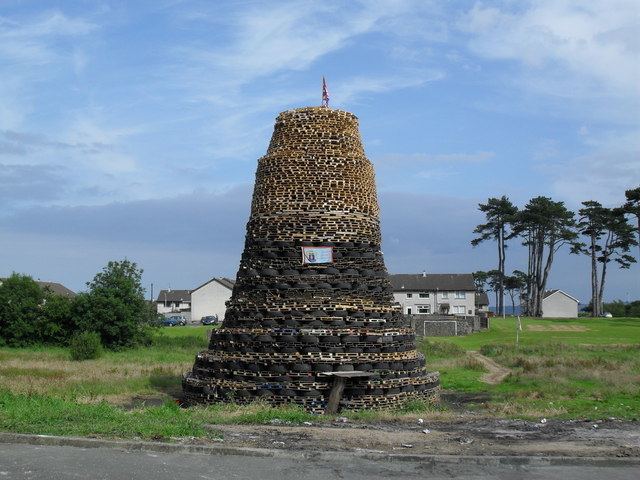 | ||
In Northern Ireland, the Eleventh Night or 11th Night refers to the night before the Twelfth of July, a yearly Ulster Protestant celebration. On this night, large towering bonfires are lit in many Protestant/loyalist neighbourhoods in Northern Ireland and are often accompanied by street parties. The bonfires are mostly made up of wooden pallets and tires, with some reaching over 100 ft tall. The event has been condemned for displays of sectarian or ethnic hatred, anti-social behaviour, and for the damage and pollution caused by the fires. The flag of Ireland, Irish nationalist (including republican) symbols, Catholic symbols, and effigies, are burnt on many bonfires. There have been attempts to make the event more family-friendly and environmentally-friendly. It is also known as "bonfire night", in common with other events in which bonfires are lit.
Contents
Origins
Like The Twelfth itself, the Eleventh Night is associated with the Glorious Revolution (1688) and Williamite War in Ireland (1689–91). Tradition holds that the bonfires commemorate the lighting of fires on the hills of counties Antrim and Down to help Williamite ships navigate through Belfast Lough at night. Protestant King William III and his forces landed at Carrickfergus to fight the Catholic Jacobites, supporters of the exiled Catholic King James II who was trying to regain the British throne.
Bonfires in Northern Ireland traditionally mark the night before the Twelfth. However, should the Twelfth fall on a Sunday, as it did in 2015, the public holiday is given in lieu on the following Monday. When this situation arises, some bonfires are lit on the Saturday night.
Sectarianism and violence
Eleventh Night bonfires have involved sectarian and loyalist paramilitary displays. Symbols of Irish nationalism/republicanism (such as the Irish tricolour), and symbols of Catholicism, are often burnt on the bonfires. The tricolours on such bonfires are often daubbed with sectarian slogans such as "Kill All Taigs" (KAT) or "Kill All Irish" (KAI). Effigies, and posters of Irish nationalist election candidates, are also sometimes burnt, which has been condemned as "inciting hatred".
Polish flags were seen at a couple of bonfires in Belfast in 2012 and 2013, with an election poster for a Polish candidate on another. This was denounced as "racist intimidation" and possibly motivating others to commit hate actions.
Loyalist paramilitary groups, such as the Ulster Defence Association (UDA) and Ulster Volunteer Force (UVF), have also used Eleventh Night bonfires to hold "shows of strength", which often involve masked gunmen firing volleys of shots into the air.
Another issue that has been raised is drunkenness and alcohol-fuelled violence amongst those attending.
Environmental harm
Eleventh Night bonfires have raised health and safety concerns, as well as environmental ones.
Bonfires are often built to be as large as possible. Some have been built near houses and other buildings. Roads are often damaged and, according to the British Broadcasting Corporation, clean-up and repairs made to roads due to bonfire-related damage can "cost thousands of pounds", with some roads needing to be resurfaced.
A major concern that has risen to greater prominence in recent years is the pollution they cause. In some bonfires, despite bans by bodies such as Belfast City Council, tyres are burnt. Tyres produce many toxic chemical compounds when burnt, and therefore pose a major health issue.
Attempts to address the concerns
There have been attempts to make the bonfires more family-friendly and environmentally-friendly. In Belfast, a Bonfire Initiative has been set up. When joining the initiative, the community groups who organize bonfires agree to a number of conditions. A "bonfire committee" must be formed; the gathering of material for burning may only begin on 1 June; only wood can be burnt; and paramilitary flags and emblems must not be displayed at the bonfire site. In 2010, groups who forbore from burning nationalist flags or symbols were awarded an extra £100 funding.
In 2009, Belfast City Council began promoting "beacons" as an environmentally-friendly alternative. It is a pyramid-shaped metal cage filled with willow wood-chips, and set on a base of sand to protect the ground underneath. The willow trees re-grow within a year of being cut down, making the bonfires more environmentally sustainable. By agreeing to use the beacons, the communities qualify for up to £1,500 of funding from Belfast City Council to hold a street party – as long as they do not fly paramilitary flags or burn tyres. Some loyalist communities in Belfast have begun using the beacons. The Orange Order, whilst recognising the importance of bonfires to Protestant culture, have issued calls for the organisers of bonfires not to burn tyres. However, many others oppose the beacon, claiming that it infringes upon their traditions.
